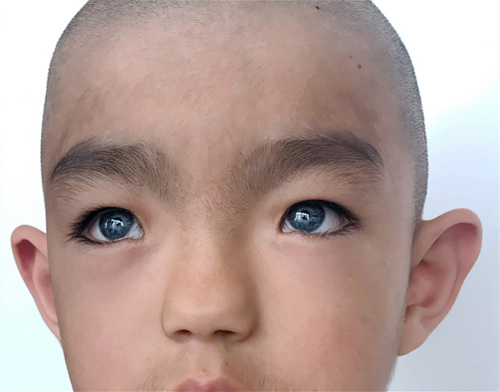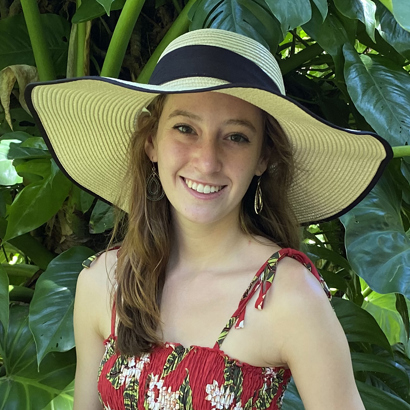
I just wanted to know if Asians carry the blue eyed allele?
February 11, 2022

- Related Topics:
- Eye color,
- Pigmentation traits,
- Complex traits,
- Population genetics
A curious adult from South Korea asks:
“I just wanted to know if Asians carry the blue eyed allele?”
Yes, some Asians do carry the "blue eyed allele". Though as you get farther away from Europe, it becomes less common1.
The map below shows the frequency of the traditional blue-eyed allele across the world:

But this isn’t the same as the frequency of actual blue eyes, which are much rarer. So while many Asians do have the “blue-eyed allele”, blue eyes themselves are still quite rare.
Why are blue eyes so rare?
Biology teachers typically teach eye color as a very simple trait. Under that model, the traditional blue-eyed allele is recessive. That means you need two copies in order to end up with blue eyes:

This brings us to the first important thing to know about the map I showed you: it showed the frequency of the traditional blue-eyed allele across the world. Allele frequency is the percentage of chromosomes that have the chosen allele. Let’s say we have a sample of five people, as shown below. Each person is shown with their two chromosomes and the resulting eye color.

Here, we'd say the allele frequency is 50% (5 out of 10 chromosomes), even though just 20% (1 out of 5 people) have blue eyes. So the percentage of actual blue-eyed people is lower than the allele frequency.
So the map above shows blue-eyed allele frequency. But how does this translate into actual, blue-eyed people?
Let's take a closer look at China, which looks to have an allele frequency of approximately 10% on the map. Doing some quick math*, we can approximate that 1% of people in China should have blue eyes.
But 1% is actually pretty high. With a population of 1.4 billion, this would mean 14 million Chinese people have blue eyes! The true number is probably a lot lower, so what's going on here? Turns out, there's a lot more to it than a single "blue-eyed allele."
The Complex Inheritance of Eye Color
To be fair, 55% of the variation in eye color (in people with European ancestry) is due to just one location in your DNA, which is near a gene called OCA22. This is what is typically considered the “blue-eyed allele”, and it’s what places like 23andMe use to predict your eye color. What’s wrong with that?
Well, this one location only explains 55% of the variation in eye color. 55% is certainly not 100%. So there must be something else contributing to the other 45%. We now know that at least sixty genetic regions interact with one another to produce a particular eye color3.
This brings us to the second issue. Our predictions only work well in Europeans. Less genetic research is done in people of other ancestries, and oftentimes the results don’t carry over perfectly.
One study of both Asians and Europeans showed that the same genes (including our friend OCA2) affect eye color in both groups… but the alleles have less dramatic effects in Asians. That is, an allele that produces bright blue eyes in Europeans might only create slightly lighter brown eyes in Asians3,4.
Also, the traditional European alleles are still at very low frequencies in Asians. That means that even though these alleles have an effect in Asians, they aren’t the major contributors to eye color diversity in Asia. In East Asians, other versions of OCA2 (different from the traditional allele) were found to have a strong effect on the darkness of the brown color. And entirely new genes were found to influence color within South Asians, including LYST and TYRP14. So it’s safe to say: eye color genetics are complicated!
So, Do They?
So do Asians carry this blue-eyed allele? Let’s give three possible answers, based on your definition of the “blue-eyed allele”.
1) Some blue-eyed Asians do carry the classic European blue-eyed allele.
Scientists think the traditional blue-eyed allele near OCA2 had a single origin in Europe 6,000-10,000 years ago5. And since the traditional blue-eyed allele is recessive, each blue-eyed person would have European ancestry on both sides of their family.
This ancestor could be very very distant, possibly hundreds of generations ago. In China, for example, the Hmong people6 and the inhabitants of the village of Zhelaizhai7 have reportedly high prevalence of blue eyes, likely due to an influx of European ancestors hundreds of years ago. There are lots of descriptions of these specific groups on the internet, even though it doesn’t look like there are any scientific papers describing them. Even in the 21st century, we still have so much genetics left to discover!!
Or the ancestor could be recent. Europeans have made repeated contact with Asia through trade, colonization, and conquest, so the blue-eyed allele may have entered your family in more recent history. It could even be one of your parents. Alexa Chung, a British writer and model with Chinese ancestry, likely owes her blue eyes to her British mother8.

2) Someone with the traditional blue-eyed allele might still have dark eyes.
Although the traditional blue-eyed allele is rare in Asian populations, there are still a considerable number of people who have it. So why are there still so few blue-eyed Asians? As I said before, genetic predictions often don’t carry over from one ancestry group to another.
We now know that the traditional allele for blue eyes in Europeans leads to slightly-lighter brown eyes in Asians. So even if you have the traditional allele, it still needs to interact with multiple other genes to produce blue eyes. If you have the traditional allele but none of these modifier genes, then your eyes might be a slightly lighter brown3,4. In other words, you could carry the blue-eyed allele, but not have blue eyes.
Having a European ancestor would increase the chance that you have both the traditional allele and the modifier genes, producing blue eyes. So, blue eyes in Asians could still be the result of European ancestry, but they’re a bit harder to get because both the traditional allele and the modifier genes have to come from the European ancestor.
3) Blue eyes can be caused by other genetic variants.
After reading #1 and #2 above, you might consider the traditional blue-eyed allele fundamentally European. That’s a matter of perspective. But even if Asians do not carry THE blue-eyed allele, could they still have A blue-eyed allele? That is, could there be a different gene that gives rise to blue eyes in Asians? It’s very possible.
The truth is, we simply don’t have enough research studies on lighter-eyed Asians to find out what causes blue eyes. It’s entirely possible that rare Asia-specific mutations could produce lighter eyes. Currently, we’ve just discovered the genes responsible for the various shades of brown.
There are a couple of exceptions. For example, a genetic condition called Waardenburg syndrome is responsible for the striking blue eyes found in the people of Buton, an island in Indonesia8. The condition causes other pigmentation differences and deafness as well, but it’s an example of how genes completely unrelated to OCA2 can cause blue eyes9.

So what’s the verdict?
There are plenty of blue-eyed Asians. This probably happens when the traditional blue-eyed allele comes into a family from a (possibly very distant) European ancestor. Blue eyes then resurface in a child generations later if they inherit the allele from both parents.
But we also know that eye color is not a simple trait, with many genes all interacting with each other to produce the final eye color. So it’s entirely possible that some blue-eyed Asians have a different allele to blame. Without more research, blue-eyed Asians may seem, well, out of the blue!
*Quick math: You can estimate this with the Hardy-Weinberg equation. Consider two alleles, A and B, that have allele frequencies of p and q, respectively. If a population is in Hardy-Weinberg equilibrium, then the expected proportion of people with two A alleles is p2, the proportion of people with one A and one B is 2xpxq, and the proportion of people with two B alleles is q2. So if our blue eyed allele is at 10% frequency, then the proportion of people who have two blue eyed alleles is 0.1x0.1=0.01=1%.

Author: Alyssa Lyn Fortier
When this answer was published in 2022, Alyssa Lyn was a Ph.D. candidate in the Department of Biology, studying the evolution of immunity-related genes in Jonathan Pritchard’s laboratory. She wrote this answer while participating in the Stanford at The Tech program.
 Skip Navigation
Skip Navigation
